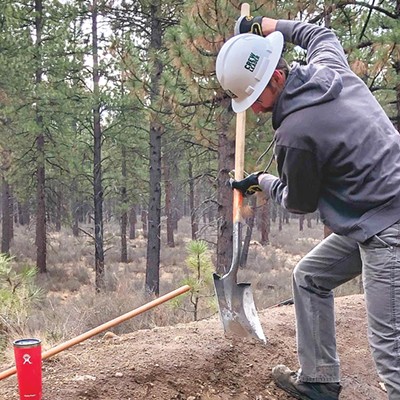At lunchtime on a recent Wednesday afternoon, 20 elementary school children file out the door of the Tumalo Community School and into a mobile trailer with the words, "Child Evangelism Fellowship" emblazoned on its side. After some brief chatter, the students take their seats, dig into their hamburgers and stare expectantly at the adult at the front of the room, who quickly grabs their collective energy and attention by leading them in what has become a familiar song for the group.
"Good news! Good news! Christ died for me. Good news! Good news! If I believe; Good news! Good news! I'm saved eternally. That's wonderful EXTRA (with fist pump) good news!"
After settling down inside the Good News Club trailer, the students spend the next hour studying Bible verses, asking questions about God and earning prizes, as their peers eat lunch and run on the playground 150 yards away. The scenario is nothing new in Central Oregon where the Good News volunteers have been proselytizing outside public schools for decades. Today, though, its relationship is closer than ever thanks to court rulings that have opened up public schools to religious groups like the national Good News Club organization. It's an uneasy truce. Many religious groups including Good News would like more access to the classroom. Meanwhile civil liberties groups and some parents think that religious groups are operating too freely within earshot of the secular schoolyard.
It's the fact that Bible lessons are happening adjacent to public school property during the school day that has some parents raising their eyebrows and questioning whether the school district is doing enough to police religious organizations like the Ponderosa Chapter of the Good News Club.
At Tumalo Community School, one of the 19 public schools in Central Oregon visited by the Good News Club, the Ponderosa Chapter has two of these 35-foot long white trailers, each complete with benches, white boards and Bible verses tacked to the walls. Local chapter leaders estimate that they work with 400 to 450 students each month. Students are involved with consent from parents, who must sign permission slips allowing the children to visit the trailers.
"I think, in the public school, it's important [for students] to learn as much as they can about Jesus and the Bible and their faith," says Kim Hockin, who is a volunteer teacher and whose children attend the Good News Club at Bend's Pine Ridge Elementary, which she leads.
But other parents are not as enthused and find the close relationship between schools and the Good News Clubs confusing and troubling.
"It's just like a billboard beside the school," says Paula Bullwinkel, a substitute teacher and parent of a child at Juniper Elementary. "You don't provide religious services at school. It just makes me mad."
Trailers are just one way that the clubs reach out to public school students. The Good News Clubs conduct meetings inside several school buildings, albeit after regular school hours, a little-known fact that's made a number of parents feel like they've been left in the dark.
"The concern I have is that fuzzy line between religion and public schools, especially if they're holding meetings in the school," says Kolleen Yake, a parent of an Elk Meadow student.
CLUBS ARE LEGAL, BUT SCHOOLS HAVE DISCRETION
In 1962, the U.S. Supreme Court ruled state-sponsored school prayer unconstitutional (see: Abington School District vs. Schemmp). But a 2001 Supreme Court case (Good News Club vs. Milford Central School District) ruled in favor of the clubs and stated that the Clubs' right to free speech had been violated by the district. The Court decided that the Good News Club should be afforded the same access to school areas as other non-religious clubs. School districts have some leeway, however, and some have banned the Good News Clubs. In Minnesota, the Elk River Area School District prohibited the clubs from passing out materials at open houses. In 2009, the Childhood Evangelism Fellowship, the Good News Clubs' parent organization, challenged and had the ban overturned, but courts ruled that school districts are permitted to restrict access to non-school clubs, as long as that it is done unilaterally. Elk River responded by adopting a closed forum policy, which only allows district materials to be distributed to students.
Interestingly, members of the Bend-La Pine school board are shaky on the district's policy surrounding the faith-based clubs. Board member Beth Bagley, a deputy district attorney who is running for judge, said she was unaware of the Clubs' existence, and fellow board member Kelly Goff notes that while she does not allow her own children to attend the Clubs, she is unaware of any overarching district policy on the matter.
"I don't believe religion should be taught in public schools," said Goff. "I do know that there are a lot of friends that feel the same way I do. I also have friends who are deeply religious and feel strongly about the clubs. And, you know, to each his own."
The Bend-La Pine School District has, however, set guidelines on what material can be advertised on the school grounds. One of the districts' three guiding policies on the matter states, "material will have educational value and will enhance the district program."
Flyers for the Clubs are located in school offices and on bulletin boards next to adverts for AirLink and Camp Fire USA. From the flyers to the trailers parked out back, so far, principals within the district say that the Good News Clubs have not caused a disruption.
"It's really not for me to say (whether the presence of the Clubs is right or wrong) since it's a constitutional right," says Tumalo Community School Principal Michelle Herron.
THE STUDENT EXPERIENCE
After singing their welcome song, in the trailer outside Herron's school, the Good News Club volunteer teacher launches into her weekly Bible verse lesson. This week is John 3:16 - which says that God gave the world his only son and that whomever believes in him shall live eternally. As the hour wears on, the children become increasingly fidgety, but ask some tough questions of their volunteer leader.
"Who is God?" asks one child. "If God created the universe, who created God?" another wants to know.
Even if elementary students don't fully understand the explanations, they have an incentive to come back. Volunteers hand out candy and other treats for attendance and participation. They also seek to make missionaries of the young audience. If the students bring in their peers from school, they will be rewarded with points and prizes during their next visit to the trailer.
"All [I] wanted to do was go into the trailer because of the candy," says 25-year-old Bend native Naime Conrad, who visited the Good News Club as a first-grader at Bear Creek Elementary. As a youngster, all Conrad understood was that kids came out of that trailer with candy and she wanted some, too.
Yake, the Elk Meadow parent, worries that young students might view the trailers as Conrad did and lump the practices of the Club with their school experience.
"To them it's sort of fun, but there's a conversion there that's their ultimate goal. It seems extremely targeted to a very vulnerable population of students," says Yake.
THE ORGANIZATION'S BACKGROUND
While the atmosphere in the Good News Clubs is in many ways similar to the nearby public school classrooms, there are some key differences. Most notable is the fact that the curriculum is set not by teachers and education professionals but by a group with a distinct political ideology that is rooted in the group's conservative evangelical philosophy and taught by a volunteer who has completed a one-and-a-half-hour-long training session, according to the Ponderosa chapter's co-directors Betty and Terry Edwards.
The Clubs' parent organization, Child Evangelism Fellowship, founded in 1937, operates worldwide and has three ministries geared toward children. A hyper-organized and well-funded machine, the CEF certainly has the means to reach even more children in the future. The organization counts roughly 750 full-time employees and a small army of volunteers. An audited financial statement from June 2011, puts the CEF's total assets at nearly $10 million. In 2001 alone, 16,805 children were involved with Good News Clubs in the U.S. By 2009, that figure grew to 139,221, an increase of 728 percent, according to a recent book Good News Club: The Christian Right's Stealth Assault on America's Children by Katherine Stewart who spent roughly two years researching the organization.
In the course of her research, Stewart, who has reported for the New York Times and Reuters, came across, THE PLAN, a comprehensive, 400-plus-page guide outlining how to start up a Good News Club. Well scripted and rehearsed, the multi-million dollar organization leaves little to chance, she says.
"It's kind of like the McDonald's of evangelism," says Stewart in a recent phone interview.
Even though the volunteer-led Good News Clubs operate in more than 3,000 public schools, little has been reported on them, until the release of Stewart's book this past January. In the book, Stewart reveals details about the financial and political engine behind the Good News Club and its fundamentalist leanings.
Last year, when Stewart attended the CEF's triennial National Convention in Talladega, Ala., she says she found the messages from the keynote speaker, Dr. A. Charles Ware, to be filled with pro-creationism, anti-homosexual and anti-interracial marriage rhetoric.
"If people really understood what kind of religion is being taught, they would be less likely to send their kids," Stewart says.
CEF bills itself as "a Bible-centered, worldwide organization that is dedicated to seeing every child reached with the Gospel of the Lord Jesus Christ, discipled and established in a local church." But Stewart's book asserts that what parents see at the clubs isn't necessarily the bottom line.
Such fundamentalist messages are not absent from the local Good News Clubs, which teach creationism and refer to homosexuality as a sin, according to organizers.
Not surprisingly, some parents find those kinds of messages alarming.
"It sounds like they are training children to preach," Bullwinkel says. "To me it's propaganda."
LONG HISTORY IN CENTRAL OREGON
While court rulings have helped to pave the way, the clubs have a long history in Central Oregon. Good News Club, Ponderosa Chapter, serving Deschutes, Jefferson and Crook Counties, has been operating in the area since 1968. Betty Edwards, co-director of the Ponderosa Chapter, has been at the helm of the evangelical program for 12 years. As director, her duties include soliciting donations from area churches, driving the trailers, coordinating with schools and teaching new volunteer leaders. Before she took over as a director she was involved with the clubs as a volunteer herself and pressed her husband to do the same.
"We prayed about it and I was drawn in," says Terry Edwards, Betty Edwards' husband, who along with her is a co-director of the local Ponderosa chapter. Currently, there are 19 Good News Clubs in Central Oregon, which is down from a reported 31 clubs in 2007.
"We want children to hear about Jesus Christ," says Terry Edwards. "We offer a gift."
Hockin, a volunteer at Pine Ridge Elementary and parent, sees the Clubs as just that.
"I want every child to know that Jesus loves them," she says.
Hockin has been a volunteer Good News Club teacher for five years and reports that she's seen the number of her students swell from six kids, when she first started, to 23. Three of her own children attend her lessons, too.
"They love it," she says. "I think the one thing that they enjoy is that the Bible is full of adventure stories and you know kids love those stories."
As the week's lesson winds down at the trailer outside Tumalo Community School, the volunteer leader fields more questions, leads more songs and hands out candy and other prizes before releasing the children back to their classrooms - a 30-second walk away, across a gravel turn-around area and a line between schools and religion that is becoming more and more hazy around Central Oregon and across America.























